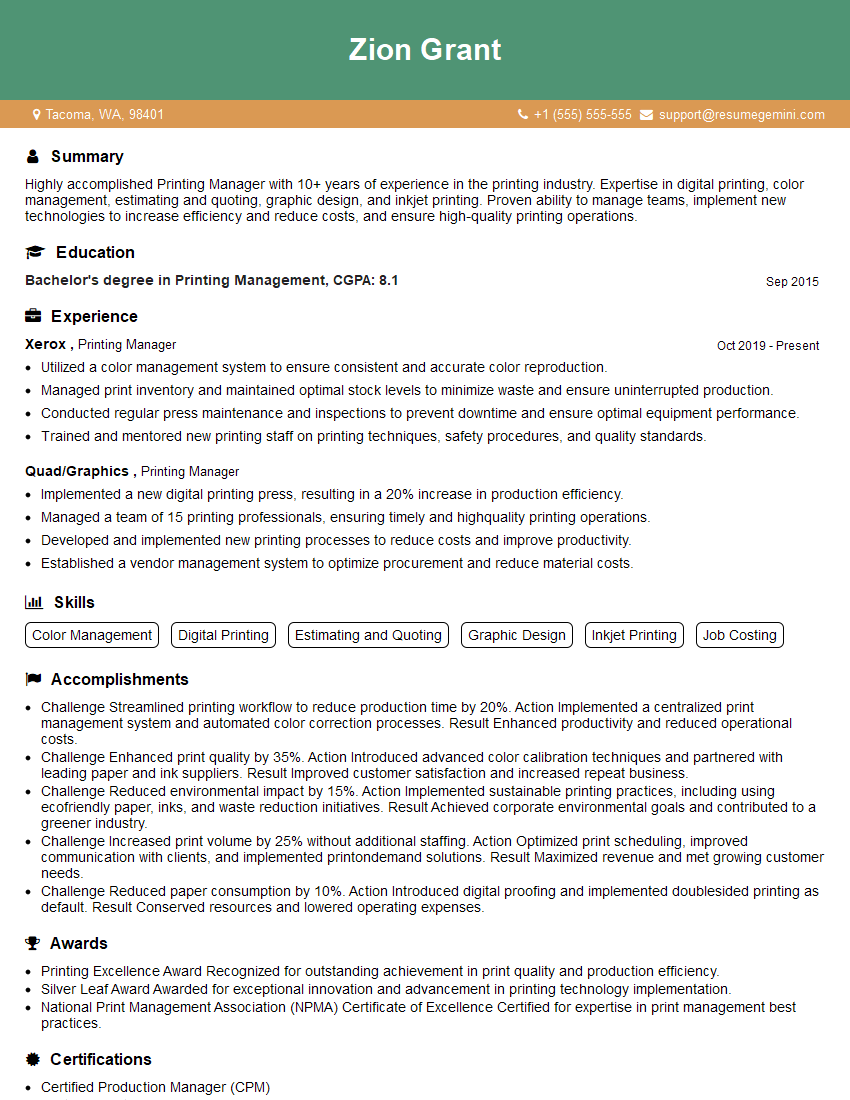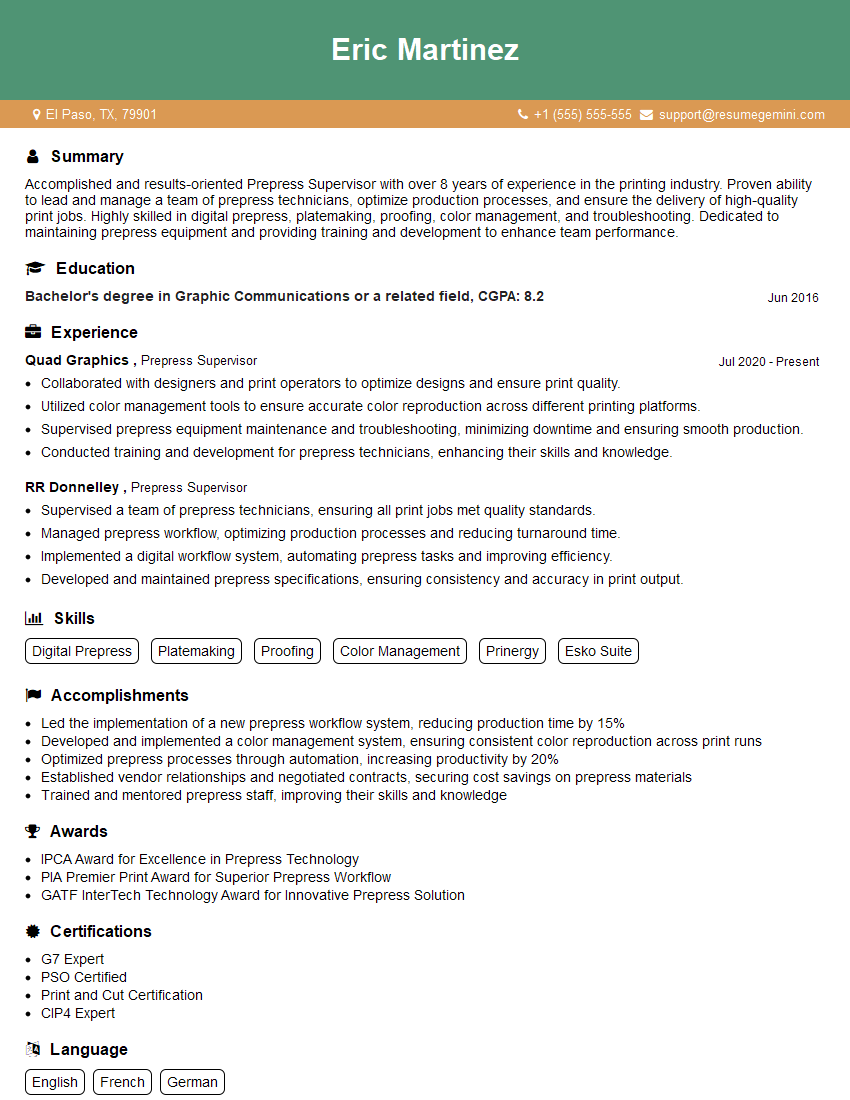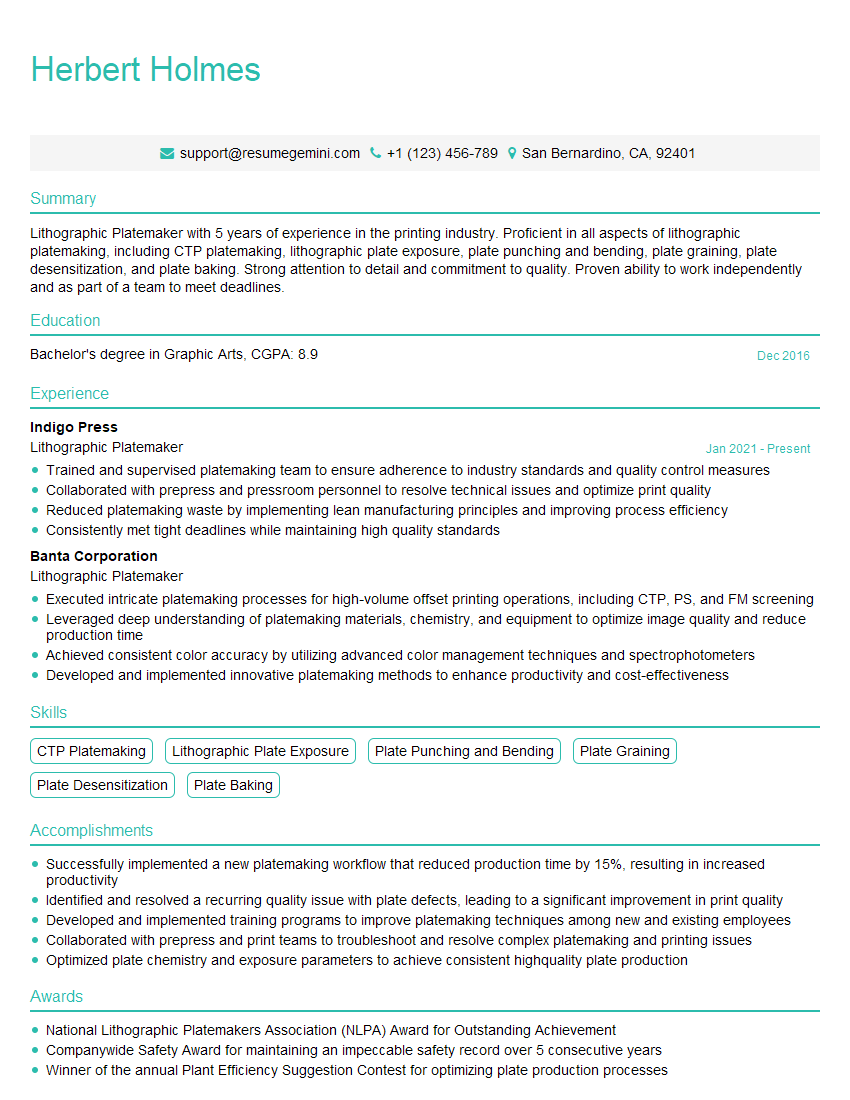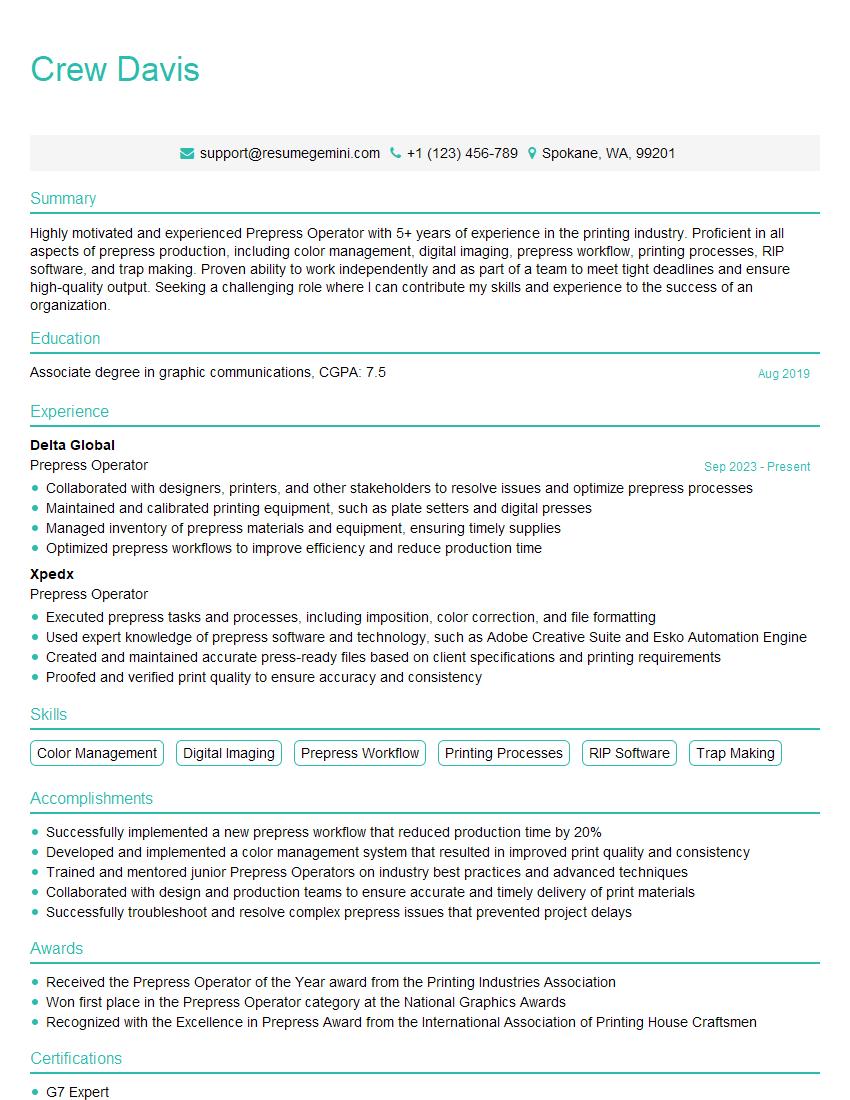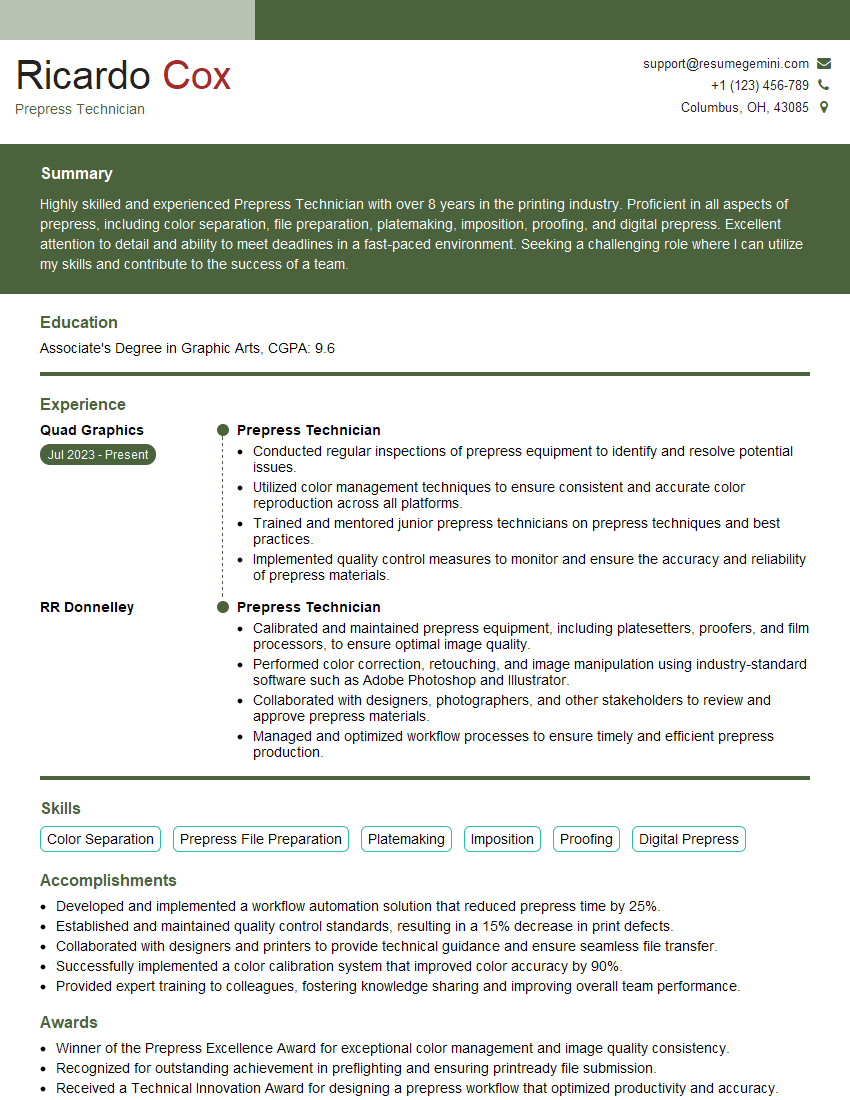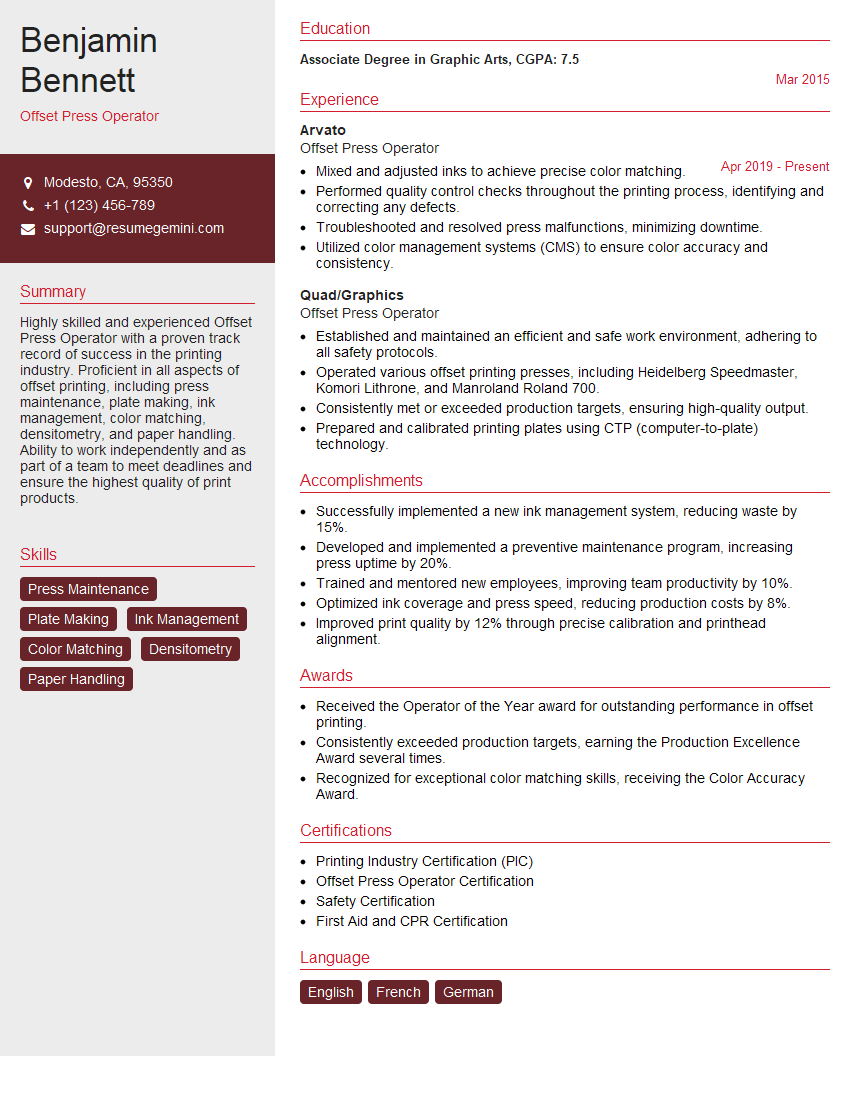Feeling uncertain about what to expect in your upcoming interview? We’ve got you covered! This blog highlights the most important Lithographic Platemaking interview questions and provides actionable advice to help you stand out as the ideal candidate. Let’s pave the way for your success.
Questions Asked in Lithographic Platemaking Interview
Q 1. Explain the process of creating a lithographic printing plate.
Creating a lithographic printing plate hinges on the principle of hydrophilicity (water-loving) and lipophilicity (oil-loving). We’re essentially creating a surface where ink (oil-based) adheres only to specific areas, while water repels it from the rest. This is achieved through a series of steps. First, the plate is coated with a light-sensitive emulsion. Then, an image is exposed onto the plate, either digitally (CTP) or traditionally using film. The exposed areas become hydrophobic (water-repelling) while unexposed areas remain hydrophilic. Next, the plate goes through a chemical processing step where the unexposed areas are washed away, leaving behind the image. Finally, the plate is gummed, further enhancing the image’s ink receptivity, and is ready for printing.
Think of it like this: Imagine a sponge. The image is like the part of the sponge that has been coated in wax – the ink will stick to the wax only. The rest of the sponge will absorb water and repel the ink. This selective ink adhesion is the heart of lithography.
Q 2. What are the different types of lithographic plates?
Lithographic plates come in various types, each with its own strengths and weaknesses. The choice depends on the printing press, the desired print quality, and budget considerations.
- PS Plates (Photosensitive Plates): These are traditional plates requiring film for image transfer. They are cost-effective but slower to produce than CTP plates.
- CTP Plates (Computer-to-Plate): These are exposed directly from digital files, eliminating the need for film. They offer higher precision, faster turnaround times, and improved automation.
- Thermal CTP Plates: These plates use heat to expose the image, offering high resolution and excellent image quality. They are often preferred for high-quality printing such as fine art or packaging.
- UV CTP Plates: These use ultraviolet light for exposure, offering excellent stability and longer life compared to thermal plates. They’re commonly used for large-format printing.
Within each category, there are further variations in material composition and coatings designed for specific press types and inks.
Q 3. Describe the role of Computer-to-Plate (CTP) technology in platemaking.
Computer-to-Plate (CTP) technology has revolutionized platemaking, offering a significant leap in efficiency and quality compared to traditional film-based methods. In CTP, a digital image file is directly transferred to the plate using a laser or other imaging device. This eliminates the intermediate film step, leading to several advantages:
- Increased Speed and Efficiency: CTP drastically reduces production time, allowing for faster turnaround and improved workflow.
- Improved Accuracy and Precision: Digital imaging reduces the risk of errors inherent in film-based processes, leading to sharper images and better dot reproduction.
- Enhanced Quality Control: CTP systems often include software for pre-press quality control, helping to catch potential problems before printing begins.
- Cost Savings (Long Term): While the initial investment in CTP equipment can be substantial, it often pays off in the long run due to increased efficiency and reduced waste from film and chemicals.
For example, a printing house producing high volumes of short-run jobs using CTP can save significant time and labor costs compared to those still reliant on traditional film-based platemaking.
Q 4. How do you ensure proper plate registration?
Proper plate registration is crucial for accurate color alignment and print quality. It ensures that multiple color plates register perfectly onto the same area on the substrate. Misregistration leads to blurry images and misaligned colors. Here’s how we ensure it:
- Precise Plate Mounting: Plates are mounted onto the printing press with extreme accuracy using precision tools and alignment pins.
- Registration Marks: Registration marks, tiny crosshairs, are included in the image files. These marks are used by the press to align the plates.
- Regular Calibration: Printing presses need regular calibration to ensure accurate registration. This involves adjustments to the press’s mechanical components.
- Pre-press Quality Control: Thorough pre-press checks, including verification of the registration marks on proofs, are essential in preventing registration issues.
Imagine trying to build a house without precise measurements. The result would be wobbly and unstable. The same principle applies to registration: if your plates aren’t registered perfectly, your printed piece will be flawed.
Q 5. What are the common issues encountered during platemaking, and how do you troubleshoot them?
Common issues in platemaking can range from poor image quality to physical defects on the plate. Troubleshooting involves systematic analysis and problem-solving.
- Poor Image Quality: This can stem from low-resolution images, incorrect exposure, or chemical processing problems. The solution involves checking image resolution, optimizing exposure parameters, and ensuring proper chemical handling.
- Plate Defects: Scratches, pinholes, or other physical defects can ruin a plate. Careful handling, proper storage, and regular inspection are critical.
- Ghosting: This is a faint, unwanted image appearing on the printed sheet, usually due to improper plate processing or ink transfer. Addressing it requires adjusting the processing steps or using different chemicals.
- Mottle: Uneven ink distribution on the plate, leading to patchy prints. This usually stems from plate surface imperfections or improper ink handling.
Troubleshooting often involves a process of elimination. Start by examining the plate, then check the processing steps, and finally, review the pre-press files and settings. Keeping detailed logs of production parameters is helpful in identifying recurring problems.
Q 6. Explain the importance of image quality in platemaking.
Image quality in platemaking is paramount because it directly impacts the final printed product. A high-quality image ensures sharp details, accurate colors, and a professional finish. Poor image quality leads to blurred images, inaccurate color reproduction, and overall unsatisfactory results.
Consider this: A billboard with a blurry logo will not make a good impression. In the same way, poor image quality in platemaking will negatively affect the perceived quality of the printed material, whether it’s a magazine, a book, or packaging.
Factors affecting image quality include: the resolution of the digital files, the quality of the CTP system, proper exposure and processing, the choice of plate material, and the printing press itself. Each stage needs meticulous attention to detail to achieve the desired quality.
Q 7. What are the different types of plate materials and their properties?
Plate materials vary in their properties, influencing factors like cost, durability, and printing characteristics.
- Aluminum: The most common base material due to its cost-effectiveness, lightweight nature, and ability to accept various coatings. Different alloys offer varying levels of durability and scratch resistance.
- Polyester: Offers excellent dimensional stability and is suitable for flexographic printing, where plates are frequently bent and flexed.
- Polycarbonate: A high-performance material known for its durability and resistance to scratches and chemicals. It’s preferred for long runs and high-quality applications.
Each material’s properties dictate its suitability for different printing processes and applications. For example, aluminum plates are widely used in offset lithography, while polyester and polycarbonate are more suitable for flexography or certain types of digital printing.
The choice of plate material is a critical decision, influencing not just the final print quality but also the operational efficiency and overall cost of production.
Q 8. How do you maintain and clean lithographic plates?
Maintaining and cleaning lithographic plates is crucial for consistent print quality and extends the plate’s lifespan. The process depends heavily on the plate type (e.g., PS, CTP), but generally involves several steps. First, we remove any excess ink or debris using a plate cleaner specifically designed for the plate material. This often involves a specialized cleaning solution and a soft cloth or sponge, taking care not to scratch the delicate surface. For CTP plates, a thorough cleaning with a solvent-based cleaner is usually sufficient. For plates that have been exposed to water-based inks, a detergent-based cleaner might be necessary, followed by a rinse. Next, we inspect the plate for any damage, such as scratches or pinholes, that might affect print quality. We may use a magnifying glass for careful inspection. If necessary, minor imperfections may be addressed using specialized plate repair tools. Finally, the plate is meticulously dried and stored properly – protected from dust, UV light, and extreme temperatures – to prevent deterioration.
For example, I once worked with a client who had consistently subpar print quality due to inadequate plate cleaning. After implementing a thorough cleaning regime and switching to a high-quality cleaning solution, we drastically improved the print consistency and minimized waste.
Q 9. Describe the process of plate mounting.
Plate mounting is the process of securing the lithographic plate onto a cylinder within the printing press. This needs to be done precisely to ensure accurate registration and consistent printing. The process generally starts with preparing the plate cylinder by cleaning and ensuring it’s free from any debris or imperfections. We then apply a mounting tape or adhesive specifically designed for this purpose. The type of adhesive will vary based on the plate material and the press type. The plate is carefully positioned on the cylinder, aligning it accurately using registration marks. Once aligned, a firm pressure is applied, ensuring proper adhesion and preventing slippage during the printing process. This might involve using a roller or a specialized mounting tool to ensure even pressure distribution. Finally, we inspect the mounted plate to ensure it’s securely fastened and properly aligned. Any misalignment can lead to significant print problems.
Think of it like putting a picture in a frame – the cylinder is the frame and the plate is the picture. If the picture isn’t centered, the whole image is skewed! Precision is key here.
Q 10. What is the significance of dot gain in lithographic printing?
Dot gain in lithographic printing refers to the increase in the size of halftone dots during the printing process. Essentially, the dots on the printed page are larger than those on the plate. This happens due to several factors including ink spread, paper absorption, and the press itself. Too much dot gain results in darker and muddier prints, losing detail and contrast. Too little dot gain can lead to weak and pale prints that lack impact. Controlling dot gain is essential for achieving the desired color and density in the final print. We achieve this through careful control of the printing process, including ink viscosity, pressure, and paper selection. Accurate color management from design to print is equally important. Color profiles and proof are used to compensate for predicted dot gain.
Imagine a printed image with tiny dots. Dot gain makes these dots spread out, like water spreading on blotting paper. Managing it is about ensuring the picture looks as the designer intended.
Q 11. Explain the concept of halftone screening in relation to platemaking.
Halftone screening is a crucial technique in lithographic platemaking that allows us to reproduce continuous-tone images (like photographs) using only dots of varying sizes. Instead of reproducing every shade of gray directly, halftone screening converts a continuous-tone image into a pattern of dots that simulate different tones through their varying sizes and spacing. These dots are then transferred to the lithographic plate. Different screening angles and frequencies are used depending on the color being printed to avoid moiré patterns (unwanted visual artifacts resulting from overlapping screen angles).
Think of a newspaper picture. While it looks continuous, a close look reveals tiny dots of varying sizes, creating the illusion of shades of gray and color. This is halftone screening in action.
Q 12. How do you handle different color profiles (e.g., CMYK, Pantone)?
Handling different color profiles, like CMYK (Cyan, Magenta, Yellow, Black) and Pantone, is a critical aspect of maintaining color accuracy in lithographic printing. CMYK is a subtractive color model used for four-color process printing, while Pantone is a spot color system, employing premixed inks for specific colors. We use color management software, such as Adobe Acrobat or dedicated RIP (Raster Image Processor) software, to convert the designer’s color specifications to the appropriate profiles for the platemaking process. We calibrate our platemaking equipment to ensure consistent color output. Profiles are created using color charts to standardize the color production across different devices and materials. This ensures the printed output closely matches the designer’s intended colors.
For example, a Pantone color requires a separate plate, while CMYK colors are built up by combining the four process inks on a single plate. Accurate color management is essential to ensure these colors look consistent and are printed correctly.
Q 13. What are the safety precautions involved in handling platemaking chemicals?
Safety is paramount when handling platemaking chemicals. Many of these chemicals are hazardous and require careful handling. We always use appropriate personal protective equipment (PPE), including gloves, safety glasses, and lab coats. Adequate ventilation is crucial to minimize exposure to fumes. We work in a dedicated, well-ventilated area designed to handle hazardous materials. All chemicals are stored according to safety regulations. Proper waste disposal procedures are followed rigorously, ensuring compliance with environmental regulations. Regular safety training is provided to all personnel involved in the platemaking process. We have a detailed safety manual and emergency procedures in place to address potential accidents.
For instance, some plate-processing chemicals can cause skin irritation or respiratory problems. Following safety protocols is not optional but a necessity for the health and safety of everyone in the workplace.
Q 14. Describe your experience with different plate processing equipment.
Throughout my career, I’ve worked with a variety of plate processing equipment, including both computer-to-plate (CTP) systems and traditional platemakers. I have extensive experience with different types of CTP processors, ranging from thermal plates to violet laser plates, and understand their specific requirements for processing plates and different output resolutions. I’m proficient in operating and maintaining various plate imagers, processors, and exposing units. My experience also includes working with different types of plate materials (PS plates, polyester plates, aluminum plates), each with its unique handling and processing needs. This includes understanding the different processing chemicals and their impact on plate quality. I’m well-versed in troubleshooting equipment malfunctions and performing routine maintenance to ensure optimal functionality. I’ve even worked with older platemaking technology, which gives me a broader perspective and understanding of how platemaking has evolved over time.
For example, I’ve successfully migrated a print shop from a traditional platemaking process to a fully automated CTP system, resulting in a significant increase in efficiency and a reduction in processing time and waste.
Q 15. How do you ensure consistency in plate production?
Consistency in plate production is paramount for maintaining print quality and avoiding costly reprints. It’s achieved through a meticulous approach encompassing every stage, from initial file preparation to final plate processing.
- Standardized Processes: We rely heavily on Standard Operating Procedures (SOPs) for each step, from imaging parameters to plate processing chemistry and times. This ensures everyone follows the same best practices.
- Regular Calibration: Equipment like plate imagers and processors need regular calibration using standardized test plates. This helps detect and correct any deviations in exposure, processing, or other critical parameters. We maintain detailed calibration logs for traceability.
- Quality Control Checks: Throughout the process, we conduct numerous quality checks, often using densitometers to measure the density of the imaged plate and a microscope to inspect the plate for any defects. These checks often lead to immediate corrective actions.
- Environmental Control: Maintaining consistent temperature and humidity in the platemaking area is vital. Fluctuations can impact the chemistry and lead to inconsistencies in plate quality. We use climate-controlled environments to minimize these effects.
- Material Consistency: We source plates and chemicals from reputable suppliers, ensuring consistent batch-to-batch quality. We also maintain rigorous inventory control to avoid using outdated materials.
For example, if a plate consistently shows lower density in a particular area, we investigate the imaging parameters, the plate itself, or even potential environmental factors like temperature variations to identify the root cause and adjust accordingly.
Career Expert Tips:
- Ace those interviews! Prepare effectively by reviewing the Top 50 Most Common Interview Questions on ResumeGemini.
- Navigate your job search with confidence! Explore a wide range of Career Tips on ResumeGemini. Learn about common challenges and recommendations to overcome them.
- Craft the perfect resume! Master the Art of Resume Writing with ResumeGemini’s guide. Showcase your unique qualifications and achievements effectively.
- Don’t miss out on holiday savings! Build your dream resume with ResumeGemini’s ATS optimized templates.
Q 16. Explain the importance of quality control in platemaking.
Quality control (QC) in platemaking isn’t just about catching errors; it’s about proactively preventing them and ensuring consistent, high-quality output. A robust QC system translates directly into reduced waste, lower production costs, and improved customer satisfaction.
- Preventing Rework: Early detection of problems during platemaking minimizes rework and avoids wasting expensive materials. A simple density check, for instance, can prevent printing hundreds of flawed copies.
- Maintaining Brand Consistency: Consistent plate quality is crucial for maintaining the visual identity of a brand across different print runs. QC ensures the final product matches the design intent.
- Meeting Customer Specifications: Strict adherence to customer specifications is vital. QC helps ensure the final plates conform to the required dot gain, density, and other critical parameters, avoiding costly corrections later.
- Data Tracking and Analysis: Comprehensive data logging from each stage of platemaking allows us to identify trends and potential issues proactively. Analyzing this data can lead to process improvements and prevent future problems.
Imagine a scenario where a client expects specific color accuracy. Our QC procedures, including spectrophotometer readings and color profiles, guarantee the final printed product meets these expectations. Without stringent QC, inconsistencies in color could ruin an entire print job.
Q 17. How do you interpret and use technical specifications for platemaking?
Technical specifications are the blueprint for platemaking. Understanding and applying them accurately is essential. These specifications typically include information on the type of plate, resolution, screen ruling, dot gain, density, and ink coverage.
- Plate Type: The specification will identify the type of plate (e.g., thermal, violet, UV) needed, dictating the imaging and processing parameters.
- Resolution: The required resolution (in lines per inch or dpi) determines the level of detail achievable. Higher resolution demands more processing power and potentially more expensive plates.
- Screen Ruling: The screen ruling (lines per inch) impacts the tonal range and sharpness of the final print. Specifications define the optimal ruling for a specific application.
- Dot Gain: Dot gain refers to the increase in dot size during printing. Specifications often define acceptable dot gain values to ensure accurate color reproduction.
- Density: Density measurements ensure the plate has adequate ink-holding capacity. Specifications detail acceptable density ranges.
For example, a specification might state ‘Use a violet CTP plate with a 175 lpi screen ruling, targeting a dot gain of 15%, and a minimum density of 1.8D’. We would configure our imager and processor accordingly and use QC procedures to confirm that the produced plate meets all these parameters.
Q 18. What is your experience with different platemaking software?
My experience encompasses several leading platemaking software packages, including those from manufacturers like Creo (now Kodak), Agfa, and Fuji. These software packages manage the prepress workflow, from file preparation and imposition to creating the instructions for the plate imager.
- Prepress Workflow Management: I’m proficient in using software to manage color profiles, trap settings, and other prepress elements. This ensures consistent color and image quality across different jobs.
- Plate Imposition: I have experience using software to arrange individual pages (or images) on a printing plate, optimizing plate usage and minimizing waste.
- RIP Software (Raster Image Processors): I understand how RIP software converts digital files into the format readable by plate imagers. This includes managing resolution, screening, and other crucial settings.
- Quality Control Modules: Many software packages include integrated quality control features, including density prediction and other automated checks. I am familiar with using these features for proactive QC.
For instance, I’ve used Creo’s Prinergy workflow to manage complex jobs requiring highly accurate color reproduction and precise imposition. My expertise extends to troubleshooting issues within these software packages and optimizing settings for improved efficiency.
Q 19. Describe a time you had to solve a complex problem during platemaking.
During a large-scale print job for a major retail client, we experienced a sudden increase in plate defects – specifically, pinholes leading to ink bleeding on the printed materials. The initial reaction was to replace the plates, but this wasn’t a sustainable solution, especially given the tight deadline.
My approach involved a systematic troubleshooting process:
- Data Analysis: We reviewed our platemaking logs, focusing on the time the defects started appearing. This pointed towards a potential issue with the processing chemistry.
- Chemical Analysis: We checked the processing chemistry for contamination or degradation. A trace amount of a foreign substance was found in the developer solution.
- Root Cause Identification: After investigating the storage and handling procedures, we found a minor leak in a storage container for the developer, contaminating the batch.
- Corrective Action: We replaced the contaminated developer, thoroughly cleaned the processing equipment, and implemented stricter storage protocols.
- Verification: We produced a test plate to verify the correction, and the defect disappeared.
This incident highlighted the importance of proactive monitoring, thorough investigation, and meticulous record-keeping in platemaking. The quick resolution avoided significant delays and maintained our client’s satisfaction.
Q 20. How do you stay updated with the latest advancements in platemaking technology?
Staying updated in this dynamic field requires a multi-pronged approach:
- Industry Publications: I regularly read trade journals like Printing Impressions and WhatTheyThink, staying informed about new technologies and industry trends.
- Trade Shows and Conferences: Attending events like drupa provides hands-on experience with the latest equipment and networking opportunities with other professionals.
- Manufacturer Websites and Webinars: Keeping abreast of new product releases and updates from major equipment manufacturers through their online resources is crucial.
- Professional Organizations: Membership in relevant professional organizations, such as associations focused on printing and prepress technologies, provides access to educational resources and networking opportunities.
- Online Courses and Training: Continuous learning through online courses keeps my skills sharp and enhances my expertise in new technologies.
For example, recent advancements in UV-LED curing technology for plates have significantly reduced energy consumption and environmental impact. Staying updated on such developments is critical for optimizing our processes and ensuring sustainability.
Q 21. What are the environmental considerations in platemaking?
Environmental considerations are increasingly important in platemaking. We aim to minimize our impact through several strategies:
- Waste Reduction: Implementing efficient workflow processes to minimize plate waste. Careful planning, accurate imposition, and regular maintenance of equipment all play a role.
- Chemical Management: Using environmentally friendly processing chemicals and employing proper storage and disposal methods to avoid contamination. We follow all relevant local and national environmental regulations.
- Energy Efficiency: Utilizing energy-efficient equipment, such as UV-LED plate imagers, to reduce energy consumption. We also monitor energy usage and implement measures to further improve efficiency.
- Recycling: Participating in recycling programs for used plates and other materials, wherever possible. We prioritize suppliers who emphasize sustainability in their manufacturing processes.
- Water Conservation: Employing water-saving technologies in our plate processing equipment and regularly maintaining the equipment to prevent leaks.
For instance, we’ve recently switched to a new plate processor that uses less water and fewer chemicals, significantly reducing our environmental footprint. Sustainability isn’t just a trend; it’s a core value driving our operations.
Q 22. Explain your experience with different types of printing presses.
My experience encompasses a wide range of printing presses, from traditional sheet-fed offset presses to modern high-speed web offset and even some experience with digital printing technologies. I’ve worked extensively with Heidelberg, Komori, and Manroland presses, gaining familiarity with their unique functionalities and maintenance requirements. For example, with Heidelberg Speedmaster presses, I’ve become adept at managing the color registration and perfecting units, ensuring high-quality output. Working with web offset presses has broadened my understanding of high-volume production and the importance of consistent ink delivery and paper handling. My exposure to digital presses has given me a broader perspective on the industry’s technological advancements and the increasing integration of digital and offset technologies.
This diverse experience has honed my understanding of the interrelationship between the platemaking process and the press itself. A properly made plate, precisely aligned and processed, is crucial for optimal press performance. Any flaw in the platemaking process can significantly impact print quality, leading to issues like color inconsistencies, slurring, or poor registration on the press. Therefore, my understanding of various press types allows me to tailor the platemaking process for optimal results on the specific machine.
Q 23. How do you manage your workload and prioritize tasks in a fast-paced environment?
In the fast-paced environment of prepress, effective workload management is crucial. I employ a combination of techniques to prioritize tasks. First, I use a project management system to meticulously track all incoming jobs, deadlines, and client requirements. This allows me to visualize the entire workload and identify potential bottlenecks. I prioritize tasks based on urgency and importance, using a matrix to categorize jobs as high-priority/urgent, high-priority/not urgent, low-priority/urgent, and low-priority/not urgent. This helps me allocate my time effectively and avoid last-minute rushes. Furthermore, I proactively communicate with colleagues and clients to manage expectations and ensure seamless workflow.
For example, if I have several jobs with tight deadlines, I might delegate some tasks that can be handled by others while focusing my attention on the most critical aspects of the most urgent jobs. This collaborative approach ensures that we meet all deadlines while maintaining consistent quality. Regularly reviewing my schedule and adjusting priorities based on unforeseen circumstances is also a key element of my approach. This flexibility is key to successfully navigating the ever-changing demands of a busy prepress department.
Q 24. Describe your experience with workflow management systems in prepress.
I have extensive experience with various workflow management systems (WFM) commonly used in prepress, including MIS (Management Information Systems) software like EFI PrintSmith Vision and prepress workflow automation systems like Kodak Prinergy. My expertise includes setting up jobs, managing color profiles, reviewing proofs, and tracking the progress of jobs from initial design to final plate output. These systems streamline communication, improve efficiency, and reduce errors. For instance, using Prinergy, I can automate various tasks like trapping, imposition, and color management, ensuring consistent quality across all jobs.
I understand the importance of integrating these WFM systems seamlessly with the platemaking equipment, creating a continuous digital workflow that minimizes manual intervention and potential for errors. My familiarity with various file formats (PDF, TIFF, etc.) and their implications on the platemaking process further enhances my ability to utilize these systems effectively. I am also comfortable troubleshooting and resolving any technical issues that may arise within the workflow process. For example, I’ve successfully identified and resolved issues related to color discrepancies between the soft proof and the final output, utilizing the WFM system’s diagnostics tools to pinpoint the source of the problem.
Q 25. How do you work effectively as part of a team in a print production environment?
Effective teamwork is essential in a print production environment. My approach emphasizes open communication, active listening, and a collaborative spirit. I believe in proactively sharing information, anticipating potential challenges, and supporting my colleagues to achieve our shared goals. I’m comfortable taking initiative and assisting others as needed, always striving to create a positive and productive work environment. I have found that collaborative problem-solving is often the most effective method to tackle unexpected obstacles or technical issues.
For example, I frequently work closely with designers to ensure that the artwork is prepared correctly for optimal platemaking. This collaborative effort from the outset can prevent costly errors and delays later in the process. Similarly, I actively communicate with the press operators to ensure that the plates I produce meet their specific requirements and help them avoid any press-related challenges. This proactive communication builds trust and fosters a smooth workflow, allowing the entire team to work effectively towards a common goal.
Q 26. What are your strengths and weaknesses in relation to platemaking?
My strengths lie in my deep understanding of the technical aspects of platemaking, including the intricacies of various plate types (CTP, thermal, and offset plates), their processing parameters, and the impact of these factors on print quality. I possess strong troubleshooting skills and the ability to efficiently identify and solve problems related to plate defects, registration issues, and color inconsistencies. My experience with a wide range of platemaking equipment and software makes me a versatile asset to any team.
One area where I’m actively working on improvement is expanding my knowledge of the latest advancements in plate technology and automation systems. While I’m proficient with existing technologies, I recognize the importance of staying abreast of the industry’s rapid evolution. I am currently pursuing online courses and attending industry webinars to enhance my understanding of these newer technologies and their integration within existing workflows.
Q 27. Where do you see yourself in 5 years in relation to your career in print?
In five years, I envision myself as a highly skilled and experienced lithographic platemaker, potentially in a supervisory or lead role. I aim to be a recognized expert within the company, contributing to process improvements and training newer team members. My goal is to leverage my technical expertise and leadership skills to optimize the platemaking process, leading to increased efficiency, reduced costs, and enhanced print quality. This includes mastering new technologies and integrating them effectively within our workflow.
I am also interested in exploring opportunities to share my knowledge through mentoring or training programs, further contributing to the overall success of the company and fostering professional growth within the team. My long-term aspiration involves playing a pivotal role in implementing and optimizing advanced platemaking technologies, pushing the boundaries of print production excellence.
Q 28. Why are you interested in this specific Lithographic Platemaking position?
I’m highly interested in this specific lithographic platemaking position because of your company’s reputation for high-quality printing and its commitment to innovation in the industry. The opportunity to work with state-of-the-art equipment, coupled with the chance to contribute to a team known for its expertise, is incredibly appealing. The description of this position aligns perfectly with my skills and experience, especially my proficiency in [mention specific technologies or processes mentioned in the job description, if available].
Furthermore, I’m drawn to the challenging and dynamic nature of this role. I thrive in environments that require both technical expertise and problem-solving skills, and I’m confident that I can make a significant contribution to your team’s success. The company’s culture, as described [mention any positive attributes of company culture, if known], resonates strongly with my professional values, reinforcing my desire to become part of your team.
Key Topics to Learn for Lithographic Platemaking Interview
- Plate Preparation: Understanding different plate types (e.g., PS, CTP), pre-press processes, and quality control checks before imaging.
- Imaging Technologies: Familiarity with various imaging methods (e.g., thermal, violet laser), their advantages, disadvantages, and troubleshooting common issues.
- Plate Processing: Deep knowledge of developing, gumming, and baking processes, including chemical handling safety procedures and environmental considerations.
- Quality Control and Inspection: Mastering techniques for inspecting plates for defects (e.g., pinholes, scratches, contamination) and implementing corrective actions.
- Press Operation & Integration: Understanding how platemaking processes directly impact print quality on the press and troubleshooting printing problems related to plate issues.
- Color Management and Proofing: Knowledge of color profiles, soft proofing, and how to ensure accurate color reproduction from digital file to final print.
- Workflow Optimization: Identifying bottlenecks in the platemaking process and implementing strategies for increased efficiency and reduced waste.
- Health and Safety: Understanding and adhering to all relevant safety regulations and procedures related to chemicals, equipment, and waste disposal.
- Troubleshooting and Problem Solving: Developing practical problem-solving skills to identify and resolve issues that arise during platemaking, ensuring consistent high-quality output.
- New Technologies and Trends: Staying updated on advancements in platemaking technology and their potential impact on efficiency and print quality.
Next Steps
Mastering Lithographic Platemaking is crucial for career advancement in the printing industry, opening doors to specialized roles and higher earning potential. A strong, ATS-friendly resume is your key to unlocking these opportunities. To make your application stand out, we strongly recommend using ResumeGemini to build a professional and impactful resume. ResumeGemini offers a user-friendly platform and provides examples of resumes tailored to Lithographic Platemaking, helping you present your skills and experience effectively to potential employers.
Explore more articles
Users Rating of Our Blogs
Share Your Experience
We value your feedback! Please rate our content and share your thoughts (optional).
What Readers Say About Our Blog
good
